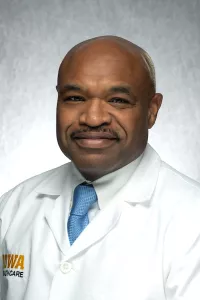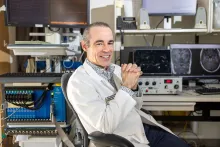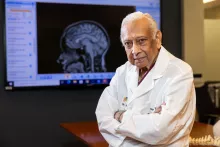Chiari Malformation
- For Neurosurgery related requests:
- 1-319-356-2237
- For Neurosurgery related requests:
- 1-319-356-2237
Chiari malformations are a group of conditions that affect the brain and spinal cord. They occur when the brain doesn’t fit properly within the skull, forcing some brain tissue to drop down into the spinal canal. This can lead to symptoms like headaches, muscle weakness, and trouble swallowing.
Most Chiari malformations that cause symptoms must be treated by a neurosurgeon. And few neurosurgeons are as familiar with Chiari malformations as those from University of Iowa Health Care.
No matter what type of Chiari malformation you have, you can count on our team for exceptional care. We’ve developed some of the surgical techniques and treatment guidelines that have helped transform Chiari malformation care for children and adults around the world.
Chiari malformation types and symptoms
Our team treats all types of this condition, including:
- Chiari malformation type 1: Brain tissue is gradually squeezed downward over time, as the skull and brain grow. Symptoms usually don’t show up until adolescence or adulthood.
- Chiari malformation type 2: This type is congenital (present at birth). It nearly always occurs with a spine abnormality called spina bifida (the backbone and spinal cord don’t close properly).
- Acquired Chiari malformation: This type is caused by an injury or illness, such as a brain tumor that takes up too much room in the skull.
Symptoms of Chiari malformation vary, depending on the type you have and the amount of displaced brain tissue.
Some people don’t have any symptoms at all; they may find out they have Chiari malformation during tests for other conditions. Others develop symptoms that take a toll on their quality of life.
Headaches are the most common sign of Chiari malformation type 1. These headaches may be severe, and often occur in the back of your head and upper neck.
- Other symptoms, which can appear at any age, include:
- An abnormal, sideways curvature of your spine (scoliosis)
- Balance problems
- Muscle weakness (or stiffness) in your back, shoulders, arms, or legs
- Numbness or tingling in your hands or feet
- Swallowing problems
People with an acquired Chiari malformation (caused by an injury or illness) may have similar symptoms.
Most babies born with Chiari malformation type 2 also have a type of spina bifida called myelomeningocele. This means there is an abnormal opening in the spine. Part of the spinal cord and spinal nerves push through this opening and balloon out of the baby’s back.
Because these conditions tend to occur together, babies may have symptoms of both. They’re usually apparent right after birth or in early infancy and include:
- Arm weakness
- Breathing pauses (apnea)
- Constipation
- Failure to thrive
- Fussiness
- Quick downward eye movements
- Swallowing problems
Diagnosing Chiari malformation
If you or your child have any of the above symptoms and haven’t found treatments that help, turn to UI Health Care.
We have the skills and experience necessary to distinguish Chiari malformation from other disorders. This is important because symptoms of Chiari malformation can mimic those of other, less serious neurological conditions.
With proper treatment, many people with Chiari malformation go on to live relatively normal, healthy lives. But finding the right treatment starts with an accurate diagnosis.
Chiari malformation treatment from UI Health Care
The treatments you may need for Chiari malformation depend on several factors. These include:
- The type of malformation you have
- The severity of your symptoms
- Whether your condition has caused complications such as scoliosis or spine instability
Your treatment plan may include:
- Watchful waiting: If you don’t have symptoms, you may not need any treatments. Your provider will monitor you over time to make sure your condition doesn’t worsen.
- Medicine: If you only have mild symptoms, such as occasional headaches, your doctor may recommend you try a nonsurgical treatment such as over-the-counter pain medication.
- Surgery: If your symptoms make it hard to get through the day, you’ll likely need brain surgery or spine surgery to correct the skull or spine abnormalities that cause them.
Chiari malformation surgery
Our neurosurgeons offer every type of surgery you may need to improve or overcome your symptoms. These include:
Your surgeon makes an opening in the tissue that covers your brain (dura mater) and sews in a patch made of human tissue or artificial material. This increases the size of the dura mater, creating more room for your brain and the fluid that surrounds it. One of the artificial patches that is used by surgeons today was developed by UI Health Care providers.
Your surgeon removes the back side of a vertebra (one of the bones that makes up your spine). This widens the spinal canal, taking pressure off your spinal cord and nerves.
Your surgeon removes a small piece of bone from the back of your skull. This creates more space for the lower back part of your brain, which sits at the base of your skull.
Your surgeon welds together two or more unstable bones in your spine to create a single, stable bone.
Our team treats patients of all ages, including infants and children; University of Iowa Stead Family Children’s Hospital is home to a pediatric Chiari malformation program.
And whenever possible, we use less invasive techniques such as transoral (through the back of the mouth) or endonasal (through the nose) approaches. Not only can these techniques help you recover more quickly, but some of them were perfected right here at the University of Iowa.
Expert treatment for any Chiari malformation complication
Some people with Chiari malformations have other medical problems, too. That’s because certain disorders are more common in people with Chiari malformations. And, if left untreated, Chiari malformations can cause serious complications.
These other medical conditions and complications include:
- Craniovertebral junction (CVJ) disorders: Problems with the bones that connect the base of your skull to your spine.
- Hydrocephalus: Fluid build-up in the brain. This may occur if cerebrospinal fluid doesn’t flow properly between your brain and spinal cord.
- Hypermobile Ehlers-Danlos syndrome (EDS): Your joints stretch more than normal, increasing your risk of injury.
- Syringomyelia: A fluid-filled cyst inside the spinal cord. This cyst can grow, putting pressure on your nerves.
- Tethered cord syndrome: Part of your spinal cord gets stuck on nearby tissue. When you grow or move, it may stretch and become damaged.
UI Health Care neurosurgeons have the skills and experience it takes to treat any of these problems. We also try to combine treatments for multiple conditions or complications into a single surgery, reducing your need for additional procedures.
Our Care Team


Need help finding a Chiari malformation expert?
Locations and Offices

Related Health Topics
Patient Stories
Related News

